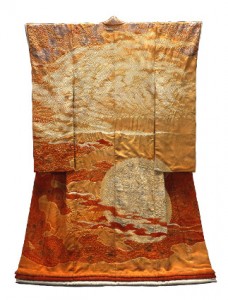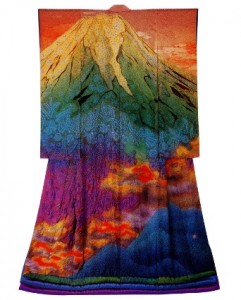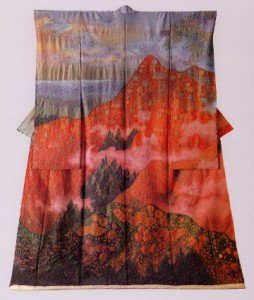
This article has originally been published in the online version of the HandEye magazine, and is republished with permission. All photographs are courtesy of the Itchiku Kubota Museum, Kawaguchi-ko, Japan.
In 1937 a young, talented yuzen Kimono artisan stumbled over a seemingly unpretentious looking textile exhibit at the Tokyo National Museum – an encounter that marked the rest of his life and lent fuel to decades of quiet experimentation and research. The exhibited cloth dated from the late Muromachi Period (1333-1573) and showed a faded series of flowers created in Tsuji-ga-hana (辻が花) technique – a combination of tie-dyeing, stitch resist, brush-painting, applied metallic leaf and sometimes even embroidery. The technique suddenly disappeared from all records at about the same time the cloth was created, which has lead to it being jokingly referred to as ‘ghost dyeing’. Itchiku Kubota decided then and there that one day he would recreate the dye results he saw – an urge that in equal intensity he only felt once more during his life time: in his three years as a Russian prisoner of war, triggered by the intensely vivid colours of the Siberian sun set.
These two turning points in Kubota’s life, combined with a deeply felt admiration of nature and the coming and going of seasons, planted the seeds to what in the present possibly is the most extraordinary body of work any Kimono artisan – certainly any contemporary artisan – ever created.

In addition to selected key works of Kubota’s career, the museum is home to his principle creation, the ‘Symphony of Light’. This unique body of work is a collection of 2 sets of Kimonos, entitled ‘The Four Seasons’ and ‘The Universe’ respectively. Planned and drafted in all detail back in 1981, this ‘grand oeuvre’ will eventually grow to encompass a total of 80 Kimonos.

Each Kimono depicts a landscape at one stage of the four seasons as an independent image. This is then part of a compositionally linked series that continues from one robe to the next, which when contemplated from a distance or at an angle, emerges as a whole just like a traditional Japanese sliding screen. When all the Kimonos in the Symphony of Light series are displayed together in a single room, which was Kubota’s intention from the outset, the effect is that of a single work of art, with the imagery creating, expanding and changing a vista that both encloses the viewer and creates the illusion of seeing far beyond the confines of the room towards a distant horizon.
The colours chosen seem taken from nature herself: intense oranges and reds at the peak of autumn, shades of white a grey in winter, shades of pink and yellow in spring. And omnipresent yet discreetly integrated into the overall design: a repeat appearance of what is the recreated Tsuji-ga-hana dyed flowers.
However, at the time of Kubota’s death in 2003, only 34 autumn and winter themed works of the ‘Four Seasons’ series, and 5 works of the ‘Universe’ series were completed. And it is now upon the artist’s sons and former apprentices to complete the artist’s dream by following the original, painstakingly detailed design instructions. Knowing that from start to finish each piece requires a year of patient artisanry, myriads of different dye baths, as well as brush painting, embroidery and finishing steps, the mountain that remains to be climbed by his successors can only be imagined.


